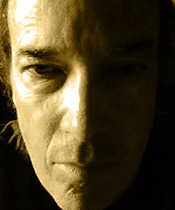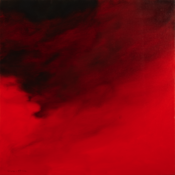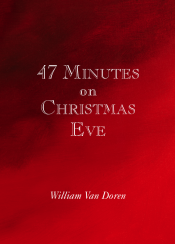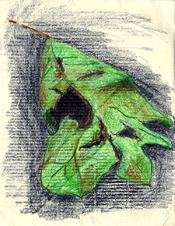Sunset, Thursday, 12 November 2009
 William Theodore Van Doren. Stony Point, Albemarle County, Va. Oil on paper, 16 x 20.
William Theodore Van Doren. Stony Point, Albemarle County, Va. Oil on paper, 16 x 20.
Even though it hasn’t really stopped raining – thanks to the monster nor’easter off the coast – I’m ready with my little aside to The Men Who Stare At Goats.
I’ve learned that some wild ideas I published an article on 28 years ago have come full circle – or maybe it would be more accurate to say, have done an acrobatic loop – and are the basis for the film. Since the ideas were new when I ran the article, and are now being satirized by Hollywood, it may be safe to conclude that they’ve gone through some sort of complete life cycle.
The story was by L.A.-based writer Bill Crandall. This was my intro to his piece, in the August 7, 1981, issue of my poster-sized publication The Wall Paper:
The Los Angeles Reader recently ran a feature story on Army Lt. Col. Jim Channon and his “First Earth Battalion.” The article explains Channon’s concept of a special ‘holistic’ ‘new age’ Army unit of ‘warrior monks’ that would conquer with deadly force if necessary but might also use ‘will’, ‘spirit’ or ‘love’. Although the Battalion does not yet exist as an operational unit, its content and objectives are being developed with the support of the Army command.
As Crandall then explained:
Channon takes himself for the focus of a dialectical synergy between the Pentagon and the New Age folks. He wants to send his soldiers out with “ginseng, amphetamines, megavitamins, herbs, and night-vision [all-natural] foods.” ... These sweeties are also to be armed to the teeth and trained in oriental martial arts. Military lunacy is nothing new, but this man wants to freak out with style, he wants his killing with spice – ritual, he says, after the manner of warpaint and feathers. Tanks blaring Black Sabbath or “something like the sound of a 110-piece black high school band really jiving ... crescendos that go higher and higher.”
When I ran the story, I pretty much decided to take Bill’s word, and the relatively sober reputation of the L.A. Reader, as reason to accept that this concept was actually being entertained by our military. But I did have my doubts. Now I find out, in 2009, it was all true all along – all this, and more. Practitioners of these, how to say, enlightened black arts, were and in some cases still are, associated with our armed forces.
If you go to the website for The Men Who Stare At Goats, to the highly informative and entertaining page by the author of the original book, you learn that there was only one man who actually stared at goats in the First Earth Battalion:
... the goat starer ... says he managed to drop one goat once, although there is no way of verifying this. The goat starer runs a dance studio in Ohio now. When I approached him for an interview I asked him if he was still practicing the technique and he said yes, and only last week he killed his hamster just by staring at it.
Actually, if I were that guy’s hamster, I might have died of a heart attack just thinking about my owner.
As funny as much of the material sounds – an Army general kept expecting to be able to walk through walls because, after all, they’re composed of tiny atoms whirling in space – the endeavor eventually made its way into what the author calls “the most whacked-out corners of George W. Bush’s War on Terror,” into diabolical torture techniques and ideas for remote killing.
Another personal connection with this stuff I didn’t know I had is a lengthy interview I did, for a client’s book, with psychic Joe McMoneagle at The Monroe Institute. I had no idea at the time (early 1990s) that the powers of ‘remote viewing’ he was describing – and he mentioned working with the government – might be used in ‘black ops’ by First Earth Battalion types.
Given these kinds of serious implications, perhaps it’s just as well that the film, overall, is apparently not nearly as entertaining as the cast and crazy material might lead you to hope and expect. One of those that, when the trailer played, my wife and I turned to each other and said, “Seems like we’ve just seen the good moments.”
Meanwhile – no big deal – but I seem to be able to make the sun go down every night by staring at it. Look for the forthcoming film.
 Thursday, November 12, 2009 at 06:16PM | by
Thursday, November 12, 2009 at 06:16PM | by  BVD | in
BVD | in  Sunset Paintings | tagged
Sunset Paintings | tagged  Bill Crandall,
Bill Crandall,  Black Sabbath,
Black Sabbath,  Blue Ridge,
Blue Ridge,  First Earth Battalion,
First Earth Battalion,  George W. Bush,
George W. Bush,  Jim Channon,
Jim Channon,  Joe McMoneagle,
Joe McMoneagle,  L.A. Reader,
L.A. Reader,  The Men Who Stare At Goats,
The Men Who Stare At Goats,  The Monroe Institute,
The Monroe Institute,  The Wall Paper,
The Wall Paper,  rain | | Comments Off
rain | | Comments Off 





Solstice and Sunset
To all who have been visiting over the past 24 hours from around the world to check out the 21 June sunset – presumably because of an interest in the solstice – well – to quote a popular song from 1950 –
If I Knew You Were Comin’ I’d’ve Baked A Cake ...
Seriously, and truly, I think the solstice has so much personal significance for me, I forgot to note the universal significance. It may be a bit late for me to consider it now, but I’ve been thinking about it quite a bit today.
As to the personal significance, among other things, I should probably explain that my wife Laura and I had our first date on the winter solstice, became engaged on the following winter solstice, and were married at the summer solstice – and the 21st and the number 21 have resonated with us, sometimes in ways that are just about unbelievable. For my part, I’m such a solstice (and equinox) watcher, I take it all somewhat for granted – it’s in the foreground. For example, I deliberately began this sunset series – the practice of painting them every single day – at the autumn equinox, 22 September 1997.
(To digress further – which is what I do best – when I was producing The Wall Paper in Los Angeles, and had to set up a regular schedule of publication in order to qualify for certain periodicals mailing rates, I wanted to publish on each full moon. However, perhaps not surprisingly, I discovered that the United States Postal Service does not care about the phases of the moon.)
So, I was thinking of what I could say to everyone about the solstice other than, “Hey, we went out to celebrate our anniversary.”
I started thinking about being a kid in Virginia, and the way I remember sometimes feeling around midsummer. These feelings are hardly an unalloyed celebration of the solstice.
It’s a largely visual memory, or a complex of implicit, unspoken feelings and ideas embodied in one moment’s very simple and singular image. The image is looking straight up from the ground in our back yard – a half-dirt, half-grass jumble – to the very top of the blue sky. In a sense, that’s all it is: blue sky.
My view sights along a very straight, very tall (60 feet or more), triple-trunked yellow poplar that stood right behind the little house near the propane tank and the broken flagstone of an unfinished patio. Above, beyond the tree – and the radio is playing “Beyond The Sea” (Bobby Darin) or perhaps Domenico Modugno’s “Nel Blu Dipinto Di Blu” – the bluest, clearest, deepest, and, somehow, hottest sky of midsummer seems to go on forever, literally in time as well as space. It’s the height of summer, and never-ending.
To a kid, that endlessness is not necessarily a completely comfortable and happy feeling. It may seem, for example, a little too hot. (It was.) Or there are too many gnats. (There were.) There also may be parents in the yard and you may feel, as children sometimes will, that you’ve crash-landed on a planet that is not altogether capable of supporting life. At the same time, the world is so amazing, and it’s presenting itself to you in all its amazingness in one image, yet it can’t be contained in that image, so the image is overflowing.
(Painting may be a search for the balance of elements that will produce that kind of overflowing image.)
Anyway, the solstice. This kid – me – or the rhetorical ‘you’ – in that moment of seeing the full height of summer, the vastness of the world, you may fear that the things you sense that are unhappy will weigh down on you forever, will never go away, while the fantastic perfection you’ve just glimpsed, the essence of summer, may never come true, may exist only for this moment, and only far away, at the top of the sky. But you seal it in your mind, in your heart, and know you’ll never let it go.
What I find so interesting and beautiful about the symbolic power of the solstice, of midsummer, and of midsummer night, is that the solstice is literally only one instant, a moment, the summit, one little tiny point, and yet it stands for everything, expresses all that is timeless, finds endless summer at summer’s height. I somehow think the human conception of solstice is a great act of faith and of imagination, and I love it, to put it simply. I think I could live there.
In a somewhat similar vein, painting the sunset every day is a recognition of time, but to me, ultimately, the observance of each day seems to break through time.
If you came here for the solstice, I hope I haven’t missed you, and I hope you’ll look around. I can say truthfully, in the words of the song: